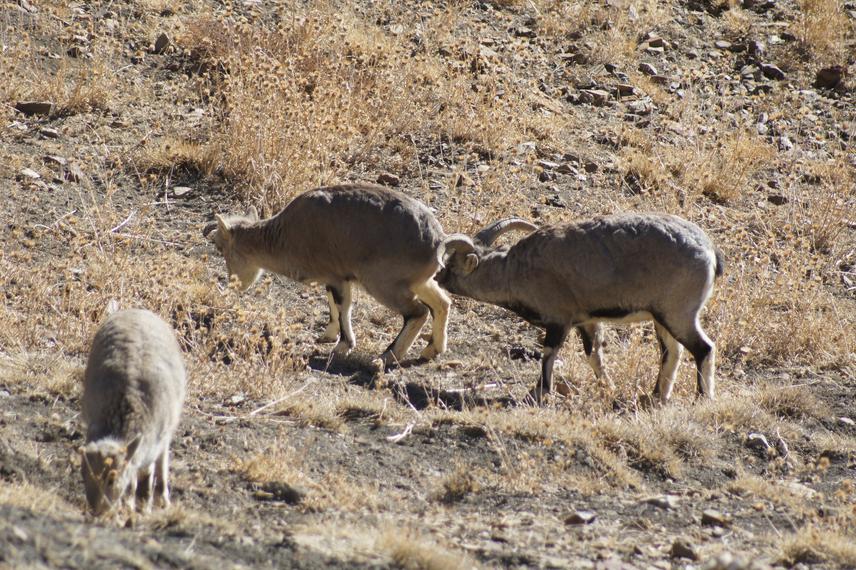Priya Iyer
This project seeks to document the extent to which the health of blue sheep and ibex populations is affected by competition and coexistence with livestock. We also attempt to understand their mating systems and age structured reproductive success.

A blue sheep male checks if a female is in estrus, while a kid grazes nearby.
The population of snow leopards in Spiti Valley is critically limited by their wild prey—blue sheep and ibex. The agro-pastoralists of this area come in conflict with snow leopards when the cats prey on livestock. Furthermore, grazing pastures are shared between the wild and domestic herbivores, and are overstocked. While the high densities of livestock are sustained by supplementary feed during the lean winter months, the populations of the wild herbivores have declined as a result of competition for forage. In recent years, livestock-free reserves have been set aside for the wild herbivores where their populations have increased. However, much remains unknown about the biology of the blue sheep and ibex, some of which this study attempts to address.
In pastures shared with livestock, wild herbivores face the risk of acquiring diseases from livestock. Moreover, competition for forage may weaken their immune system. We will measure fecal parasite loads of the wild herbivores in the reserves and grazed areas to compare their health in the two habitats. We also test for inter-specific transmission of parasites. These findings will help managers estimate the risk wild herbivores face of contacting diseases from grazing in the same pastures as livestock, and follow up with appropriate remedies. We will volunteer to train the State Forest Department officials on the simple procedures used to collect fecal samples and prepare them for analysis of parasite loads. This will help in the long term monitoring of various species of interest.
As another measure of health, we will measure glucocorticoid levels from fecal samples to estimate stress levels. We also attempt to compare the general body conditions in the two areas visually. Differences between reserves and grazed areas in parasite loads, stress levels and body condition, taken together, provide a good indicator of differences in health between the two habitats. These findings can be used to support the establishment of more grazing-free zones.
Both the blue sheep and ibex are sexually dimorphic, with males bearing exaggerated horns that grow all through their lives. Horns are expected to mediate the position of the male in the dominance hierarchy, and hence access to females. However, the social systems of blue sheep and this sub-species of ibex are not well studied. We collect baseline data about these social systems including age-structured reproductive success of males. These data are crucial for making any management decisions about the wild herbivores, such as in the case of re-introduction, culling or trophy hunting. We also compare the reserve and livestock-grazed populations with respect to group sizes, age structures, sex ratios, and the effectiveness of dominance hierarchies. Any significant differences between ungrazed and grazed social systems may direct conservation efforts to restoring the pristine social systems.